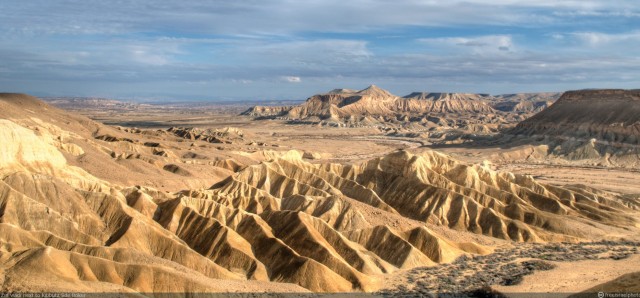Negev Desert
THE NEGEV IS A part of the Saharo-Arabian desert belt running from the ATLANTIC OCEAN across the SAHARA and Arabia to the Sind desert of INDIA's Indus Valley. The Negev, also spelled Negeb, means both “the southland” and “dry.” Negev is derived from the Hebrew verbal root n-g-v meaning “to dry.” The Ha-Negev (Hebrew) covers about 60 percent of southern ISRAEL. It is a triangular shaped arid region of some 5,019 square mi (13,000 square km). The apex of the triangle is the port city of Elat (Eilat) on the RED SEA. The eastern leg of the triangle is formed by the Syro-African Rift valley from Elat to the dead sea. The western leg of the triangle is bounded by the SINAI PENINSULA (EGYPT). The western boundary extends from the southern end of the Gaza strip coastal plain to Elat. The base of the triangle lies along an east-west line at about 30 degrees 25 minutes N.
The Negev is small in area but has five regions: the Northern Negev, the Western Negev, the Negev Highlands, the Southern Negev, Arabah (Arava). Some scholars also include the Dead Sea as a sixth area. The Northern region is a small ribbon of land running eastwest that includes the city of Beersheba (Beer Sheva) which is “the capital of the Negev.” The soils are fairly fertile, with enough rain for wheat to grow. The Western Negev stretching from the Gaza strip and the Sinai Peninsula to the Negev highlands, receives about 10 in (25 cm) of rain annually. The LOESS soils in the area are good for growing cereals.

The Negev Highlands is a high, dissected plateau averaging 1,200 to 1,800 ft (400 to 600 m) in elevation. The highest point is 3,395 ft (1,035 m). The area receives only about 4 in (10 cm) of rain per year. In this area are many erosion craters (makhteshim) formed by the erosion of the upward-folded (anticlines) limestone strata. The two largest are the Ramon Crater and the Great Crater.
The Arabah Valley (Wadi al-Jayb) is 111 mi (179 km) long, from Elat to the Dead Sea, and is bounded on the east by JORDAN. It is very arid. While the Negev is a DESERT, it is not as arid as the Sahara to the west or the Jordanian desert to the east. Many desert plants, animals, reptiles and birds flourish in the Negev. Modern irrigation projects have made many areas bloom.